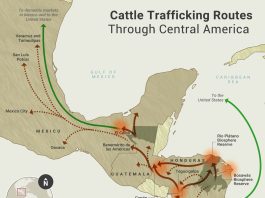
Scientists and the Farmer’s Almanac agree: this summer is going to be hotter than normal all across the U.S. and Canada. In fact, many farmers and ranchers I talk to agree that they’re seeing a trend of hotter summers over all. Everyone also agrees that heat stress reduces cattle weight gain, calf weaning weights and increases breed back failures.
What we need as it gets warmer, are cattle that are better adapted to a warmer environment. Here are a couple of options for getting there.
“Eared” Cattle
Bos indicus cattle, like Brahman or Nelore, or Bos indicus hybrids, like Brangus, Beefmaster, Santa Gertrudis, Barford, and Simbrah, have anatomical and physiological advantages that make them better equipped to deal with heat stress.
The problem with this solution, as some will tell us is that they may perform differently overall, and thanks to those ears, some find it more difficult to market them.
Use Shedding Scores to Select for Heat Tolerant Animals

If you’re not interested in eared cattle, you can select and breed for Bos taurus cattle (British and Continental breeds) that are better adapted to heat stress. According to researchers “the amount of the winter coat shed by a set date during spring or summer is an effective predictor of a cow’s ability to cope with heat stress. Earlier shedding can be an indication of improved productivity and adaptation to the production environment.” They found that cows that shed their winter coat may not be as impacted by fescue toxicosis and in hot, humid environments they wean heavier calves.
Finally, this hair shedding ability is a result of genetic differences and, though we don’t yet have a “Hair Shedding EPD” you can still make improvements to your herd. They found that “the heritability of hair shedding has been estimated to be approximately 0.35, meaning that 35% of the variation in hair shedding is due to genetic differences.
How Does Scoring Work?
To rank your cows, take a look at them in late spring or early summer. Mid-May is great if you’re in the Southeastern U.S., but as a rule of thumb, the hotter and more humid it is, the earlier in the spring you should collect your scores. You can score them as they move through a chute, or in pasture as they graze. it only takes a matter of seconds, and even when you have to find the cows that tend to hide in the middle of the herd, the researchers round that scoring takes an average of one cow per minute.
In general, cattle shed hair from front to back and from their topline to their bellies, with the lover quarter and above the hock and underline the last areas to shed. With that in mind, you can look at your cow and score her on a scale of 1 to 5:

Creating a Hair Shedding EPD
Developing new genetic predictions requires lots of data. Researchers suggest that seedstock producers in particular should work closely with their breeding associations to collect and report hair shedding scores. This can help develop future EPDs. Ultimately it will give us cattle that are more heat and humidity tolerant, and as our scientists noted, “that helps improve the most important trait of all – profitablity.”
This work was supported by grants from the USDA-National Institute of Food and Agriculture. Thanks to Dr. Jared Decker, Jane Parish for writing the fact sheet and to Drs. Darrh Bullock, Megan Rolf, Matthew Spangle, Alison Van Eenennaam and Robert Weaber of the Universities of Missour, Mississippi, Kentucky, Nebraska, Nebraska and Kansas State.





Better genetics available for heat tolerance……..shedding scores or no shedding scores or EPDs.
Comments are closed.